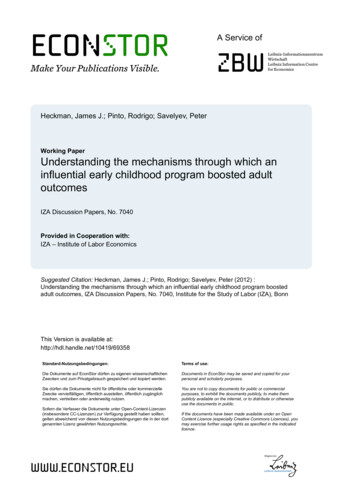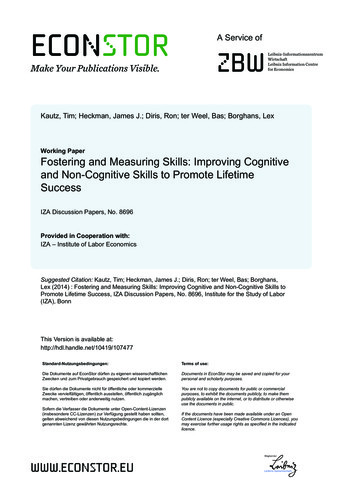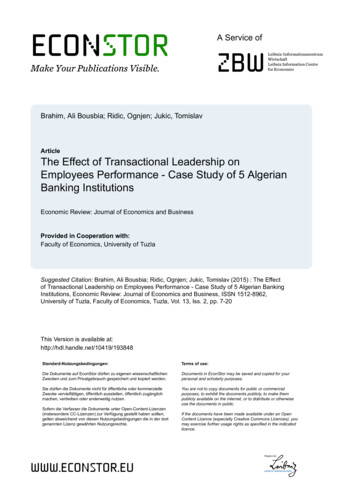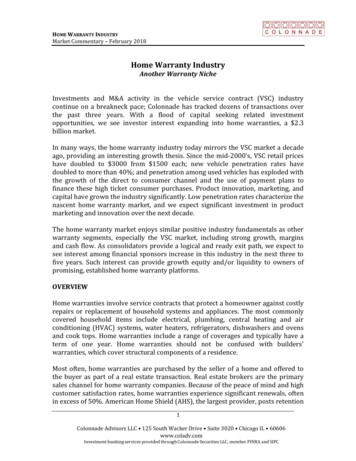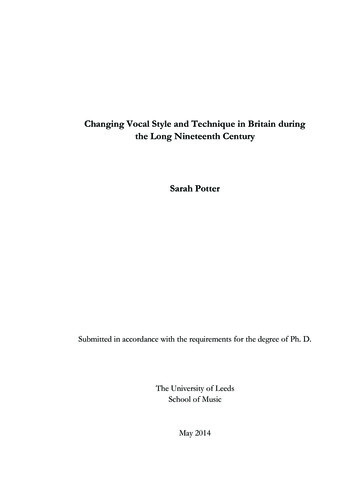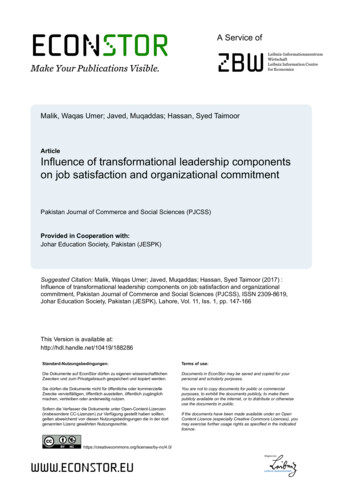
Transcription
econstorA Service ofzbwMake Your Publications iz Information Centrefor EconomicsMalik, Waqas Umer; Javed, Muqaddas; Hassan, Syed TaimoorArticleInfluence of transformational leadership componentson job satisfaction and organizational commitmentPakistan Journal of Commerce and Social Sciences (PJCSS)Provided in Cooperation with:Johar Education Society, Pakistan (JESPK)Suggested Citation: Malik, Waqas Umer; Javed, Muqaddas; Hassan, Syed Taimoor (2017) :Influence of transformational leadership components on job satisfaction and organizationalcommitment, Pakistan Journal of Commerce and Social Sciences (PJCSS), ISSN 2309-8619,Johar Education Society, Pakistan (JESPK), Lahore, Vol. 11, Iss. 1, pp. 147-166This Version is available ungsbedingungen:Terms of use:Die Dokumente auf EconStor dürfen zu eigenen wissenschaftlichenZwecken und zum Privatgebrauch gespeichert und kopiert werden.Documents in EconStor may be saved and copied for yourpersonal and scholarly purposes.Sie dürfen die Dokumente nicht für öffentliche oder kommerzielleZwecke vervielfältigen, öffentlich ausstellen, öffentlich zugänglichmachen, vertreiben oder anderweitig nutzen.You are not to copy documents for public or commercialpurposes, to exhibit the documents publicly, to make thempublicly available on the internet, or to distribute or otherwiseuse the documents in public.Sofern die Verfasser die Dokumente unter Open-Content-Lizenzen(insbesondere CC-Lizenzen) zur Verfügung gestellt haben sollten,gelten abweichend von diesen Nutzungsbedingungen die in der dortgenannten Lizenz gewährten s/by-nc/4.0/www.econstor.euIf the documents have been made available under an OpenContent Licence (especially Creative Commons Licences), youmay exercise further usage rights as specified in the indicatedlicence.
Pakistan Journal of Commerce and Social Sciences2017, Vol. 11 (1), 147-166Pak J Commer Soc SciInfluence of Transformational Leadership Componentson Job Satisfaction and Organizational CommitmentWaqas Umer MalikDepartment of Management Sciences, University of Gujrat, PakistanEmail: waqasanalyst@yahoo.comMuqaddas Javed (Corresponding author)Department of Statistics, University of Gujrat, PakistanEmail: muqaddas.javed@uog.edu.pkSyed Taimoor HassanDepartment of Commerce and Accountancy, University of Gujrat, PakistanEmail: taimoor.hassan@uog.edu.pkAbstractLeadership, job satisfaction, organizational commitment and trust have become importantprocesses for an organization in recent years. One of the contemporary human resourcemanagement functions in the organizations involves engaging in leadership development,improving organizational trust and organizational commitment and increasing jobsatisfaction. This research is conducted with an intention to investigate the impact ofcomponents pertains to transformational leadership (TL) by exercising dilemmas asemployee (satisfaction & commitment), being engaged in Islamic banking sector; whereasTL components like; idealized influence (II), inspiration motivation (IM), intellectualstimulation (IS) and individualized consideration (IC) were taken into consideration. A twostage cluster sampling design is used for the selection of sample from 5 Islamic banks ofPakistan from Gujranwala division having 56 branches. 319 employees of 25 branches areused and information is collected through structured questionnaire having 26 items onlikert scale of 5 point. The factor analysis, structural equation modeling, group meancomparison and discriminant analysis is used for the data analysis. Findings of study revealthat TL components have significant influence with respect to job satisfaction along withorganizational commitment of employees. Contribution of this study is towards bothadministrative and managerial scenarios’, yet senior management need to focus on corecomponents of TL while designing the policies for the strategic implementation.Furthermore, this investigation was conducted in only one country having unstableeconomic and political affairs that effect individuals’ moods, added inquiries needs to beconducted in better economic conditions for research exploration perspectives.Keywords: Inspiration motivation, intellectual stimulation, transformational leadershipstyle, employee satisfaction, organizational commitment.
Transformational Leadership, Job Satisfaction and Organizational Commitment1. IntroductionIn this contemporary era, leadership has significance importance when originating peopledealings for the sake of organizational success. Specifically during human dealing,involved variables getting more prominent like; employee mood, job satisfaction andcommitment along with psychological trends, according to Mosadeghrad (2003)concentration on human resource requirements are necessary for the superior performanceof the organization. Similarly, performance not only depends on skills and capability ofhuman resources but also hard working, satisfaction and loyalty of teams comprised of coreemployees. Today, organizations gain competitive advantage through strong humanresource bases, although this is very difficult in organizations having proper workforcediversity. For what, the study of Albion & Gagliardi (2007) indicated that managingemployees up to mark is all about the leadership quality in certain simple and complexsituations. That’s why nowadays well-structured companies are more concerned about theintegral aspect of leadership because it’s a decorator force which makes employeestogether.Leader applying with modern techniques prefer to adopt behavior according to employeeappropriateness, there should be the clear vision, and effective communication along withindividual consideration are the core ingredients of transformational leadership in order toenhance organizational commitment subsequent to employee job satisfaction. As compareto other leader, transformational leader expended more with subordinates and moreeffective communication take place, that is why according to study of Hayati, Charkhabi,& Naami (2014) work engagement of employee would increase through transformationalleadership attributes as; transformational leader might drive desired outcome and specificbelief by idealize influence and simply transmit inspirational motivation in employees inorder to obtain clear visionary goal and performance up to standard. In every interaction,transformational leader pursues one or more of the major component of transformationalleadership, to an extent some modifications have been compelled in invented themeregarding refined components of transformational leadership. Where componentscomprised of facets like; recognition of subordinates, charisma, subordinate inspiration bythe leader, enhancement of intellectual skills of subordinates, Bass (1999).Past research also suggested that creativity of employees be influenced by elements oftransformational leadership Wang, et al., (2014). In the modern age, organizations arefocusing on transformational leadership approach, has been identified as an organism oftransforming and changing people behavior, Hall et al., (2008). The transformational styleof leadership also influences employee performance and satisfaction level where avisionary and collaborative working capacity developed which improve overall employeemorale with respect to achievement of organizational set standards, Bass & Avolio, (1994).Transformational leadership influences outcomes similarly in culturally distinct countries,Walumbwa, et al. (2005). Stated fact followed the inquiry of Tse & Chiu (2014) identifiedthat job performance of employee and supervisor’s transformational leadership have thedirect relationship. Furthermore, Job satisfaction and organizational effectiveness risethrough potentials of transformational leadership style and overall performance boost asemployee interest increases, Adebayo, (2004). In a context, Coladarci (2014) gave the ideaabout the prediction of behavior within organizational citizenship, employee commitmentto organizational along with employee satisfaction through transformational leadershipfeatures.148
Malik et al.The second narrative is the degree if employee job satisfaction which is much debated incontemporary reforms and no doubt job satisfaction is directly related to goals set byleadership. Because the degree of job satisfaction produces self-motivated workforce so itis very integral to understand the association regarding employee satisfaction andleadership perceived by the employee to attain ultimate organizational objectives. In thesame context, Amburgey (2005) suggested some factors that have the influence onemployee job satisfaction perception consisting leadership characteristics, job experience,organizational culture, gender and qualification of employees. The study of Men (2014)showed that organizational communication and relational satisfaction of employee havethe substantial impact with transformational leadership. Where Saari & Judge (2004)argued that satisfaction of employee is the standard once employee comes to be happy withbeing employed that will result in boosting the performance and ultimately the success ofthe organization. Certainly, employee’s attitude, trust, employee’s moral, pleasant longterm relationships and profitability depends on employee satisfaction. Furthermore, for theexpansion and sensation of an organization, the degree of employee satisfaction, is anessential part of it. As satisfied employee will craft innovations and meaningful changes.The third issue is employees’ commitment and the quality of leadership drive major rolein determining the theme, in this way Stup (2005) stated that employees retain happy withthe leadership feel that they draw the worth and have value for their work. Biswas (2014)explores the concept of organizational culture and degree of employee retention withrespect to transformational leadership, as found a principal weight on employeeperformance. Researchers describe the degree of employee involvement in a job is theorganizational commitment; is also attributed as employee faithfulness and loyalty ofemployee towards the success of the organization where committed workforce have alesser rate of absenteeism and higher retention and exert higher energy level in jobs,Muthuveloo and Rose (2005). Similarly, Leadership and organizational commitment bothhave imperative influence toward organizational sensation, a good leader doesn’t go onlyfor self-benefit and keep valuable to all stakeholders especially employees in order tosustain employee commitment, Kouzes and Posner (2010). Furthermore, top managementcommitment would influence with facets of transformational leadership, Yucel et al.,(2014).Naturally, for the development of the economic life of the country, service sector can’t beneglected as Chang (2000) identified it like lifeblood and keep all other sectors of theeconomy as the dependent of it. In developing economies service industry captures a majorshare, infect service industry is such an important concern for the smooth operation of otherlinked sectors and facilitates as lifeblood, Chang (2000). The service industry in Pakistanibanking sector or financial sector is also captivating major portion for growth and infinancial institutions; selected Islamic banking sector for this research is the most emergentsector which contributes significant share for the economy in recent years. The aim of thisstudy is to explore the impact and association regarding dimensions pertains to thetransformational style of leadership with satisfaction and employee commitment to theorganization, concerning employees engaged in an emergent Islamic Banking sector.Undoubtedly, the banking sector is known as one of the major economic contributors withrespect to the service sector. Islamic banking sector with the new dilemmas and rest ofworld’s financial crises showed magnificent expansion stable results in this span. Besideother challenges, Islamic banking sector needs leaders with equipping modern149
Transformational Leadership, Job Satisfaction and Organizational Commitmentprofessionalism in order to cope with employee satisfaction and commitment issue becausewith old fashioned leadership and to maintain position in this emergent industry, it’s hard.Literature support this phenomenon in just specific behaviors of human resources and asless work has done yet on this rising issue so, there’s existence of width for examination.Thus, this research will contribute towards both administrative and managerial aspects,propose a deeper understanding of leadership as an integral factor.The rest of the paper is organized as follows. In section 2, literature from previous studiesis discussed and a conceptual framework with the hypothesis is given. The methodologyused for this study is given in section 3 and section 4 contain the results of statisticalanalysis. The discussion of the results is presented in the fifth section and the last sectionof the manuscript describes the Conclusion, recommendation, and future considerations.2. Literature ReviewLeadership is the process of shaping employees toward desired outcome, Jong and Hartog(2007). Kuchler (2008) proclaimed that leadership has attested as the world’s mostdebating topic by researchers. Organizational success and failure also depend on leadershipcapacity, Lok and Crawford (2004). According to Gill (2006) for the achievement ofdesired results; quality of leadership can drive recognition for followers, encouragement,and motivation. In literature, many styles of leadership have been contributed as laissezfaire, autocratic, charismatic, situational, bureaucratic, transactional, participative,democratic and transformational leadership, Mosadeghard (2003). Transformationalleadership is the key fundamental style for further discussion in the research.2.1 Transformational LeadershipIn very simple words, the idea of transformational leadership appealed that leaders need toencourage subordinates in order to get the desired outcome of the organization throughmotivation, healthy perceptions, beliefs and moral with effectual collaboration, Burns(1978). Afterward, researchers redirected the transformational leadership concept into fourgeneral components as charisma, inspirational motivation, intellectual stimulation &individualized consideration, Bass and Avolio (1995) where charisma/idealized influencesplit into behavioral and attributed dimensions, explained as employee beliefs, values ornorms are bases as charismatic actions of the leader. Inspirational motivation outlined as agoal or set standard achievement is through effective communication of leader whichinspires to employee and bases for self-motivation. Intellectual stimulation, on the otherhand, is the degree to which leader admit and appreciate employee to formulate innovativeassignments. Lastly, individualized consideration as refers to socio-economic supportprovided to the employee in order to empower and development.Leaders adopting the transformational style of leadership encourage subordinates towardinnovation and creativity in this way new results regards complex problems been explored,Schepers et al. (2005). According to novel findings of Warrick (2011) in contemporaryorganizational reforms transformational leader is key personnel as such type of leader haveabilities to reinvent structure of organizations according to need, although this idea is stillto promote because few organizations are familiar with core leadership style. Top et al.(2015) investigated the relationship between transformational leadership, organizationaltrust, job satisfaction, and organizational commitment as perceived by public servants andprivate sector employees in two Turkish public hospitals. They also investigated the effectsof transformational leadership, organizational trust, and job satisfaction on participants’150
Malik et al.organizational commitment. Where, Gill et al. (2006) is a big challenge is to cope with thespecific type of skills must be needed in transformational leader although exceptional.While leading change, transformational leadership contributes more valuableadvancement. Transformational leadership supports to stress reduction and confirm moreefficient working. Determinants of transformational leadership and subordinatecommitment to peruse change are strongly related, Herold et al. (2008). In a study ofGumusluoglu & Ilsev (2009) suggested creativity with effect transformational leadershipelements, have a sound association with innovation phenomenon of the organization. Onthe other script, the investigation of Wright and Pandey (2010) contributes to theunderstanding of leadership through the framework of corporate structure in moreimplementations of transformational directions. Literature suggests the effects ofemotional intelligence and personality traits with regards to transformational leadershipproperties which signifies the employee performance. The study of Choi et al. (2016) inMalaysian hospitals shows that job satisfaction among employees is affected due toempowerment and transformational leadership.Moreover, quality of leadership has an indirect effect on employee intelligence andexperience while direct impact scrutinized in transformational behaviors of leaders,Cavazotte, Moreno and Hickmann (2012). Nevertheless, employee attitude, performanceand well-being in related to transformational leadership as widely researched, Nielsen andDaniels (2012). A multilevel analysis was pursued by Braun et al., (2013) which identifiedthe association between trust, the performance of the team and employee satisfaction,where the convinced relationship withheld. In addition, transformational leadership incharismatic context found effective leadership form Knippenberg, & Sitkin (2013).Teaching leadership skills is important because young learners could learn different skillstoo, such as communication or speaking skills, decision-making skills, problem-solving,listening and persuading others; all of which require commitment and mutual trust, Keskes(2014). In another research, Zhao & Begley (2015), studied characteristics oftransformational leadership and moral modeling has a positive effect on the creativity ofemployee.2.2 Job SatisfactionThe topic of employee satisfaction is much attractive in research perspective apart frommanagerial practice as proclaimed by Lu et al. (2005). Satisfaction of employee is the deepreaction which is emotional in nature came out from job experience of the employee. Anemployee’s emotional perception about a job is the attribute of job satisfaction that eithersatisfied or not. A leader with transformational leadership needs to ensure job satisfactionof employee where there is a strong relationship between these perspectives, Nielsen et al.,(2009). Job satisfaction is also proclaimed as positive emotional state or pleasurableexperience of an employee, Luthans (2007). Gill et al. (2010) proposed that job satisfactionof employee directly influenced by transformational leadership that will further have animpact on retention of the employee. Spector (2003) explored that organizationcommitment and quality of job performance also depends on job satisfaction for the successof an organization. The performance of the organization depends on transformationalleaders those influence employee job satisfaction level, research revealed that leadershipcharacteristics influence the job performance and overall employee morale, Munir et al.(2012). Job satisfaction consisting five dimensions as promotion, coworkers, supervision,pay and work it. Also, research shows that job satisfaction has effect with personal151
Transformational Leadership, Job Satisfaction and Organizational Commitmentcharacteristics like age, experience, gender and education, Okpara (2004). Furthermore,job hierarchy (grades) experience, abilities of employee and age matter a lot in employeejob satisfaction, Oshagbemi (2003). In another similar research of Darshan (2011) identicalresults discovered. Fried and Ferris (1987) identified that for the better understanding ofjob satisfaction, just only the features related to the job are not enough personal attributesshould be considered also. Both factors corresponding; transformational leadership and jobsatisfaction could have an effect, Wang et al. (2012) and transformational leadershipimpacts in improving workers satisfaction and demoting job turnover, Cumming et al.,(2010). A positive association found between employee satisfaction (Individual level &team level) and transformational leadership. The performance of leader and quality ofsupervision also affect satisfaction of employee and leader capacity to resolve completesalso signifies in Miles and Mangold (2002). Raja and Palanichamy (2011). Study show thetransformational leadership style has an association with employee job performance.Hence, in commercial terms, we may view the job satisfaction either at the individual orteam level directly shaped by traits of transformational leadership, Braun et al. (2013). Bymeans of, transformational leadership is productive description although other leadershipstyles have effect in satisfaction and commitment of the employee to the organization,though due to supportiveness and innovativeness in nature transformational leadershipstyle was selected. Employees show much satisfaction in transformational leadership stylecomparatively to other styles as research explored that job satisfaction has substantialmeasurements through transformational leadership, Hamidifar (2009).2.3 Organizational CommitmentIntended for the organization continuous success, employee willingness to stand loyal andexpress best concerns for the well-being is the organizational commitment, Luthans (2007).A committed employee would know the organizational ethical standards, values, goals,norms and targets, Henkin and Marchiori (2003). Organizational commitment entails threecomponents as continuance, affective and normative, Shaw et al., (2003). Researchersstudies that incidents of distributed leadership, decision making in the participatoryframework and team structure of leadership, variables amongst job satisfaction andemployee organizational commitment, whereas leadership team strongly in relation withvariables, Hulpia et al., (2009). Similarly, research suggested that transformationalframeworks have significance effects with the commitment of employee, Avolio et al.,(2004). Rai & Sinha (2000) examined the association between dimensions oforganizational commitment and transformational leadership dimensions derived asanalytically factor based. Employees’ efficiency, performance, and self-motivation havealso affected the organizational commitment, Tella et al., (2007). Commitment to changedepends on good change management practices as transformational leaders; changeleadership and commitment of followers is a function of the impact of personal changes,Herold et al., (2008). Organizational commitment of strongest predictor of corporate goals,productivity, objectivities, and turnover, accordingly, Farahani, Taghadosi & Behboudi(2011) test the features of transformational leadership with emotional intelligence andcommitment of employee. Transformational leadership facilitates organizationalcommitment and employee productivity, Limsili and Ogunlana, (2008) and leader-memberexchange and organizational commitment being influenced by features of transformationalleadership, Shiva and Suar, (2010). Scholars also proclaim that affective commitment hasan expressive relationship among individual consideration and inspirational motivation as152
Malik et al.both factors contribute to integration strategy with respect to organizational commitmentinfluential, Kim and Kim (2014). As stated by Selamat, Nordin & Adnan (2013) the roleof exercising transformational leadership behavior to ignite employee commitment withrespect to organizational objectives.An important study of Joo, Yoon & Jeung (2012) parameters of leadership style astransformational and self-evaluation have an impact on commitment wheretransformational leadership has more effect compatibility because highest commitmentshown by the employee while goals, vision and intellectual stimulation have perfectlyconveyed by supervisor. The definite relationship between employee commitment andtransformational leadership style has found, Ismail and Yusuf (2009) in this way academicssupported the idea by proposing a moderate degree of employee commitment has examinedwith low degree of transformational attributes of leadership, whereas development ofqualities regarding transformational leadership are imperative with respect to shapingemployee attitudes and enhance employee retention, Ling et al., (2013). This factpatronage the research by Dunn, Dastoor and Sims (2012) instigate the relationshipemployees’ commitment and behavior of leader has a significant relationship for thesmooth development of economies.3. Conceptual Framework and HypothesisOn fabled past papers, the transformational leadership style has originated the utmostimperative leadership style determining with the satisfaction of job and organizationalcommitment of employee. Theretofore, with respect to here above research, literatureconceptual framework and novel hypothesis were drawn as,Figure 1: Theoretical Framework153
Transformational Leadership, Job Satisfaction and Organizational Commitment H1: Components of TL have effect with job satisfaction of employees. H2: Components of TL have effect with organizational commitment of employees. H3: Employee job satisfaction has effect with organizational commitment. H4: Employees perceived dissimilar degree of TL, job satisfaction & organizationalcommitment with respect to chairing position.4. Methodology4.1 Research Design, Sampling and Data CollectionUsed scheme for research designs was quantitative and study pertains to cross-sectional ina number of contacts, retrospective-prospective with referencing period vicinity and overallthis nature of the investigation was experimental as underwrites to establishing effects,Kumar (2005). Islamic Banking sector of Pakistan was selected as segment workingemployees were selected as the unit of analysis and all 5 Islamic banks were selected,Islamic Banking Bulletin (Mar 2015). As sampling frame was unattainable and notidentified so for the significance of study two-stage cluster sampling technique was appliedevidently, whereas at first stage selection of specific Islamic bank managed from the total5 banks whilst at stage two selection branch of the specific bank was considered on therandom basis in order to avoid biases. At second stage all unit elements were involved insample i-e all staff from selected branch was part of the sample, Levy and Lemeshow(2008). The portion of data collection was accomplished through questionnaire survey toolconsisting 26 items at Likert scale by interacting mentioned stakes.4.2 Research Instrument and MeasuresWith reference to above mentioned study design, primary data was collected throughstructured questionnaire; comprised of demographics, transformational leadership,satisfaction and commitment variables. Total 319 participants were involved in study withthe adequate sample size having 5% sampling inflate. Data was analyzed through SEM anddiscriminant analysis using IBM SPSS & AMOS software. MLQ multifactor leadershipscale bearing four main variables (II, IM, IS & IC) was used for measuring (TL)components developed by, Bass & Avolio (2000) [scale exercised before by researchers;Boerner, Eisenbeiss & Griesser (2007) significant results reported], employee jobsatisfaction (JS) was assessed through scale developed by, Brayfield (1951) [scaleexercised before by researchers; Judge (2000) significant results reported], whilecommitment (OC) was calculated through scale developed by, Meyer (1997) [scaleexercised before by researchers; Ragu-Nathan, Moindeepa & Bhanu (2008) significantresults reported]. Overall Cronbach’s alpha for questionnaire was found above acceptancelevel (α .7).5. Statistical Analysis Results5.1 Descriptive StatisticsThis part of study shows the demographic information, pertains to employees engaged withIslamic banking sector. Table 1 given below, describes that more than 68% employees ofIslamic banks of Pakistan are male and from all the 319 employees (respondents) 44% fallin the age category of 31 to 40 year and 32% belongs to 20 to 30 years of age. The studyalso shows that only approximately 4% employees have more than 16 years of educationwhere majority (Approximately 62%) of the employees have 16 year (Master Level)154
Malik et al.education. In our sample, 24% Managerial level employees contributed and remaining areofficer level.Table1: Demographic Facts of Islamic Banking EmployeesCategoryGenderAgeEducation / QualificationOrganizational Position 131.7Total31910020 to 3010332.331 to 4014043.941 to 504915.451 and .8Others123.8Total319100Officer Level24376.2Managerial Level7623.8Total319100Less than 15316.61 to 310131.73 to 57523.55 and more9028.2Total319100The demographic facts table also explains that most of the employees of our sample areworking in Islamic banking sector from 1 year to 3 year where 23% have 3 to 5 year Islamicbanking experience and 28% respondents are serving in Islamic banks more than 5 years.5.2 Measurement ModelsAssessment of hypothesis is based on initially to confirm latent factors; conformity factoranalysis (CFA) was applied, concerning with utilization of data for further statisticalanalysis. Missing data, outliers and reliability tests were checked through descriptive anddata screening phase. CFA was separately conducted for all factors a
Transformational Leadership, Job Satisfaction and Organizational Commitment 148 1. Introduction In this contemporary era, leadership has significance importance when originating people dealings for the sake of organizational success. Specifically during human dealing, involved variables getting more prominent like; employee mood, job .

